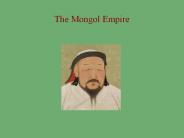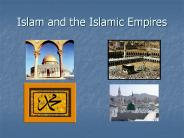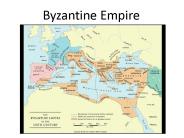The Mongol Empire PowerPoint PPT Presentations
All Time
Recommended
SSWH4b,d: The Russian Empire and the Mongol Empire Chapter 11.2 Pages 307-311 Chapter 12.2 & 12.3 Pages 330-338 The Rise of the Mongols Problems Between Steppe ...
| PowerPoint PPT presentation | free to view
AKS 33: The Byzantine Empire and the Mongol Empire Chapter 11.1 & 11.2 Pages 301-313 Chapter 12.2 & 12.3 Pages 330-338 Kiev becomes linked to Constantinople ...
| PowerPoint PPT presentation | free to download
Mongol Empire Objectives The student will demonstrate knowledge of civilizations and empires of the Eastern Hemisphere and their interactions through regional trade ...
| PowerPoint PPT presentation | free to download
Mongol Empire Chinggis Khan ... an effective psychological type of warfare where ... more directly than before This network of Mongol communication encouraged ...
| PowerPoint PPT presentation | free to download
Mongol Empire Chinggis Khan (Genghis Khan) universal ruler United all Mongol tribes and clans in 1206 Eventually amassed an army of 100,000 to 125,000 strong ...
| PowerPoint PPT presentation | free to view
Mongol Empire Chinggis Khan (Genghis Khan) universal ruler United all Mongol tribes and clans in 1206 Eventually amassed an army of 100,000 to 125,000 strong ...
| PowerPoint PPT presentation | free to download
The Mongol Empire Genghis Khan Fierce, powerful Mongol leader (1162 to 1227) Consolidates Mongolian tribes Creates a Mongolian Empire Name means Universal Ruler ...
| PowerPoint PPT presentation | free to download
The Mongol Empire Chapter 12 Sections 2 & 3 Mongol Location The Mongols began in Central Asia Steppe dry, hard grasses, cold winters, hot summers.
| PowerPoint PPT presentation | free to view
The Mongol Empire Timur the Lane Attempted to reunite to the Mongol Empire. Yet fought against other branches of the Empire (Mostly the Golden Horde).
| PowerPoint PPT presentation | free to download
The Mongol and Ming Empires Focus Question What were the effects of the Mongol invasion and the rise of the Ming dynasty on China? What military equipment is ...
| PowerPoint PPT presentation | free to download
Mongol Empire Objectives The student will demonstrate knowledge of civilizations and empires of the Eastern Hemisphere and their interactions through regional trade ...
| PowerPoint PPT presentation | free to download
The Mongol and Ming Empires Mongols Nomadic people who lived in the steppes of Central Asia Under Genghis Khan, cast empire stretched from the Pacific ocean to ...
| PowerPoint PPT presentation | free to view
The Mongol Empire (Yuan Dynasty in China)
| PowerPoint PPT presentation | free to download
Techniques of papermaking reached the Middle East. Although, Genghis Khan had subdued northern China, the Mongols needed nearly 70 more years to conquer the south.
| PowerPoint PPT presentation | free to download
The Mongol Empire World History I Focus Activity Write down the first words or phrases that come to mind when you see the following terms: Empire Marco Polo Genghis ...
| PowerPoint PPT presentation | free to view
History: The late, great Mongol Empire: origins, spread, and progeny Who were the Mongols? Nomads, pastoralists: Xiongnu (Huns) Turks Mongols Pastoralism, trade ...
| PowerPoint PPT presentation | free to view
As they became more settled, they developed a law code, written language, ... Talented calvary men and archers....even at great speeds! ...
| PowerPoint PPT presentation | free to view
conquered China to Persia, Tibet, Southeast Asia, Russia, Poland and Hungary ... Kamikaze- EARLY CULTURE. No established scripture. Rituals to please the kami ...
| PowerPoint PPT presentation | free to download
They conquered an area stretching across Asia to Europe ... well kept roads, and cities like Hangzhou as 10-12 times larger than Venice ...
| PowerPoint PPT presentation | free to view
The Decline of the Arab Empire: Turks, Crusaders, and Mongols I. Introduction Dissension and Crisis II. The Withering of Abbasid Power A. Regional Independence 1.
| PowerPoint PPT presentation | free to download
Yuan Dynasty and Mongol Empire * Above is a picture of Suzhou in Jiangsu province showing houses along the Grand Canal. From north to south, the Grand Canal is over ...
| PowerPoint PPT presentation | free to view
Mongol Empire at the Death of Kublai Khan, 1294. Map 8 3 The Mongol Empire in the late thirteenth century. Map 9 2 Medieval Japan and the Mongol invasions ...
| PowerPoint PPT presentation | free to view
The Mongols were tough, skilled warriors who lived in the saddle. ... time on their shaggy ponies, drinking mare's milk and eating only a few handfuls ...
| PowerPoint PPT presentation | free to view
converted to Islam, fought in battles, but earned little booty ... 750: defeat the Umayyad caliph in the Battle of the River Zab. The end of the Umayyads ...
| PowerPoint PPT presentation | free to view
In protecting the Kievan state, Vladimir was merciless against his enemies. ... In the 1300s Lithuania and Poland seized. territory from western Kievan Russia ...
| PowerPoint PPT presentation | free to view
Unit: The Age of Empires Topic: The Rise of the Mongols ... The Mongols
| PowerPoint PPT presentation | free to download
Mongols Genghis Khan conquered the other tribes Expanded his Empire until he died in 1227 Successors continued to expand Power struggles after his son Ogedei died ...
| PowerPoint PPT presentation | free to view
Unit: The Age of Empires Topic: The Rise of the Mongols ... The Mongols
| PowerPoint PPT presentation | free to view
Empires of East Asia China Japan Mongol Empire
| PowerPoint PPT presentation | free to download
... Empire in 1227 Mongol War Machine Conquest after Genghis Khan Mongol Empire after 1227 The Mongol Empire Yuan Dynasty Yuan Social Policies Mongol ...
| PowerPoint PPT presentation | free to view
... Ottoman Turks in the Middle East The Impact of the Mongols ECONOMIC Global trade expanded dramatically under Mongol control ... A new social structure ...
| PowerPoint PPT presentation | free to download
The Mongols Homeland Carmen Sandiego in The Gobi Desert, Mongolia That s One Mighty Big Empire Largest empire created by one single person
| PowerPoint PPT presentation | free to view
MONGOL CONQUESTS CHAPTER 12, SECTIONS 2&3 MONGOL EMPIRE-RISE Mongols were a nomadic people who grazed their horses and sheep on the steppes of Central Asia.
| PowerPoint PPT presentation | free to view
Mongols Mongols Mongols were nomadic people, who participated in trade with settled people Mongols were a tribal society, they practiced steppe diplomacy, which ...
| PowerPoint PPT presentation | free to download
Mongolian Empire I. Mongols A. Mongols lived in an area North of China B. Nomadic tribe that raised cattle, goats, sheep, and horses C. Followed their herd of animals ...
| PowerPoint PPT presentation | free to download
Despite their domination from a distance, many historians believe their impact was greater on Russia than on China or Persia. Russian princes, who were more or less ...
| PowerPoint PPT presentation | free to view
concept of mugal empire
| PowerPoint PPT presentation | free to download
The Mongols 1200-1500 Overview Traditionally reviled for their brutality Now seen as important for uniting Eurasia for 1st time Mongol empire became noteworthy for ...
| PowerPoint PPT presentation | free to download
Byzantine Empire After the Western Roman Empire fell to German barbarian invasions in the 5th century, the Eastern Roman Empire, with its capital at Constantinople ...
| PowerPoint PPT presentation | free to download
First island in the Vanuatu group was disovered by Pedro Fernandez De Quiros ... http://www.vanuatutourism.com/vanuatu/export/sites/VTO/en/activities/kava.h tml ...
| PowerPoint PPT presentation | free to download
Byzantine Empire * * No ... Cultural Foundations Christian beliefs Greek learning Roman ... Effects of the Great Schism Rise of Russia Area ...
| PowerPoint PPT presentation | free to download
The Mongols Barbarians or Men of the People and Trade Facilitators? Barbara Ozuna and Cheryl Mc Callum Paschal High School, Fort Worth, Texas
| PowerPoint PPT presentation | free to download
Gunpowder Empires 1450-1750
| PowerPoint PPT presentation | free to download
MONGOL INVASION & DOMINATION MONGOL INVASION & DOMINATION Invasion Appeared suddenly in 1223, attacked in south then disappeared Reappeared in 1237, attacking Riazan ...
| PowerPoint PPT presentation | free to view
THE MONGOLS Means for fast conquests Military Tactics Extraordinary abilities on horseback and special properties of their bows Mongol bows could shoot 1/3 further
| PowerPoint PPT presentation | free to download
The Mongols & Global Interactions AIM for Today: To gain a brief overview of the Mongols and how trading became more globalized in the 1200-1300 s.
| PowerPoint PPT presentation | free to view
The Byzantine Empire
| PowerPoint PPT presentation | free to download
Chapter 18.3: Mughal Empire I. Origins A. Located in India B. Muslims and Hindus clashed C. Turkish warlords (descendents of Mongols) established Delhi Sultanate 1.
| PowerPoint PPT presentation | free to view
Title: AP Ch13 Bulliet: The Mongols Author: Steve Collins Last modified by: Jessica Ramirez Created Date: 10/11/2005 5:35:41 PM Document presentation format
| PowerPoint PPT presentation | free to view
Islam and the Islamic Empires Some Definitions ISLAM: The Yoke or submission to the will of God MUHAMMAD: The prophet of Islam MUSLIM: A follower if Islam ARAB ...
| PowerPoint PPT presentation | free to download
The Mongols The Last Great Nomadic Challenge Chapter 14 Pg. 302-322 Periodization 1206 Mongol state founded 1206-1227 rule of Chinggis (Genghis) Khan 1215 ...
| PowerPoint PPT presentation | free to view
Byzantine Empire Objective(s) Students will be able to analyze and describe the political/social/religious developments of the Byzantine Empire after the collapse of ...
| PowerPoint PPT presentation | free to download
The Mongols - Yola ... The Mongols
| PowerPoint PPT presentation | free to download
The Mongols CH 12 Beginnings Pastoral nomads in Mongolia Organized in clans and tribes, fighting part of daily life, superior horseback warriors Unified by Temujin in ...
| PowerPoint PPT presentation | free to download
Mongol Empire (1200s - mid-1300s) Chinghis (Genghis) Khan. Largest land empire ever ... Mongol Empire. Ottoman Empire (1299-1924) Osman. Turks from Central ...
| PowerPoint PPT presentation | free to view
Mongol Eurasia & Its Aftermath 1200-1500 Nomadism in Central Asia Resources Scarce water = Pressure for tribes to move out to find new sources Complex Hierarchy ...
| PowerPoint PPT presentation | free to download
























































